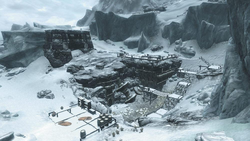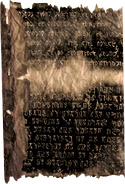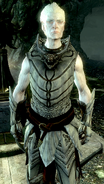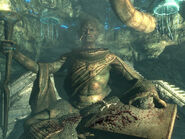
Knight-Paladin Gelebor, a Snow Elf.
The Snow Elves, occasionally referred to as Ice Elves[1], are an endangered race of Mer that were once the main inhabitants of Skyrim during the Merethic Era. It is commonly believed that centuries of underground living and Dwemer slavery twisted the race into the blind, merciless Falmer.[2][3][4]
Amongst the few known remaining Snow Elf survivors, they prefer the name Snow Elf over their original name of Falmer, as that name tends to refer to their now degenerated brethren, which after the Dwemer betrayed the Snow Elves and enslaved them, they call "The Betrayed".[4]
History
Though most of the race's history has been lost, a surviving Snow Elf by the name of Knight-Paladin Gelebor revealed the origins and fate of his race in the Fourth Era to the Last Dragonborn. He claims that they were once a "proud and prosperous race", before their war with the Atmorans and enslavement by the Dwemer.[4] According to Enthir, the Snow Elves had a society that almost rivaled that of the Altmer in the Summerset Isles.[3] The Snow Elves were also very talented when it came to magic, as can be seen by Arch-Curate Vyrthur.[5]
Merethic Era
Beginnings
Like all Mer, the Snow Elves are a descendant subspecies of the ancient Aldmer. Unlike the other races of Mer, the Snow Elves retained much of the Aldmeri culture. When they separated from them is unknown. The Snow Elves were originally a wealthy and prosperous society that made their home in portions of Skyrim. They were the first race of Mer in Skyrim and were present long before the first Atmoran colonies established by Ysgramor.[4] [3] Their origin was part of the initial exodus of dissident Mer groups from the Summerset Isles along with the Dwemer, Chimer and Ayleids, although the only Mer to settle in Skyrim were the Snow Elves and at some point, the Dwemer.[6]
Peace with the Atmorans
When the Atmorans arrived from Atmora, the Snow Elves struck up a somewhat comfortable relationship with the humans.[7] Initial coexistence between men and Snow Elves was largely peaceful. While at first peaceful, war came along shortly later.[8]
Night of Tears
- Main article: Night of Tears

Saarthal in the Fourth Era.
The peace was short-lived, as an attack by Snow Elves destroyed the rapidly growing settlement of Saarthal. It was known as the "Night of Tears".[9] [8] This raid on Saarthal destroyed the entire population of the city save for Ysgramor and his two sons. The death of his countrymen prompted Ysgramor to summon his Five Hundred Companions - the namesake and forebears of the Companions in Whiterun - and vow to drive the Snow Elves from Skyrim forever.
As they regarded the humans as a lesser species, the elves had little qualms about the slaughter they intended to commit. This genocidal spree would be known as the Night of Tears.[8]
Motivations for the Sack of Sarthaal
The Pocket Guide to the Empire, First Edition: Skyrim and Fall of the Snow Prince suggest the conflict may have been related to the rapidly increasing Nord population and a struggle for control over territory and resources which took the form of a war of extermination - with both sides apparently pursuing the utter destruction of the other.[9][10] The Night of Tears as well as the Imperial Report on Saarthal suggests the conflict may rather have been more specifically related to or escalated by the Snow Elves desire to control a powerful artifact uncovered by the Nord settlers and the Nords of Saarthal's desire to keep such power buried beneath the rocks and soil of their city.[11] The Thalmor representative Ancano as well as the Psijic Order member Quaranir take actions and make statements giving credence to the theory that this object, dubbed the Eye of Magnus, may have played an important role in the conflict.
The text KINMUNE supports the latter conclusion strongly as it identifies area under Saarthal as the site of a divine prison:
- "High King Ysgramor took the loss of the Dumb Old Giant, one of his greatest counselors outside of Torc and Talking-Belt, with great anger, and sent his Thanes and Shield-Biters against her, equipped with great relics and enchanted weapons of wasabi. And though the fight was hard, the champions of the Altmora managed to seal Kinmune beneath the always-burnt borders of Sarthaal, imprisoning her in its prismatic network of misunderstood dwemercraft."
- ―KINMUNE
Conflict with the Nords
- Main article: Nordic-Falmer War
However, this decision would cost them greatly - almost their entire society - as Ysgramor survived the attack on Saarthal and returned to the original Atmoran homeland of Atmora to raise an army. Ysgramor and his army, known as the Five Hundred Companions, would return to Skyrim to take revenge on the Snow Elves. The series of events that would soon follow would be known as The Return, and with this return, a new war would begin. As time passed, the Nords once again returned to Tamriel. They arrived back to Skyrim, and began a march across Skyrim under Ysgramor's leadership to avenge their fallen brethren. The elves would wage war with the humans for years, slowly losing to the very "creatures" they had culled in years prior.[10]
Battle of the Moesring
- Main article: Battle of the Moesring
The Snow Elves were broken and scattered, following numerous losses to Ysgramor and his Companions, and retreated to the island of Solstheim for safe harbor. Led by an elf only known as the Snow Prince, the Snow Elves took a final stand against the Nordic people, and, inspired by their leader, it seemed as though they'd come out victorious. The Battle of the Moesring, which was to be the last battle against the Nords, the Snow Prince was slain by a child by the name of Finna, who, in her grief after the death of her mother, had stabbed him.[10]
The death of the Snow Prince caused the elves' hope to be shattered with many attempted to flee the battle. It is not known what the exact date of this loss was but it was towards the end of the Merethic Era.[10][12]
With the elves' military broken once and for all the Nords then mounted a genocidal campaign and killed Snow Elves by the thousands.
Interactions with Sai
Following their defeat, the Snow Elf resistance that fought back against the nords was eradicated. Sai had agreed to help all living creatures of Nirn with his luck. In an attempt to help the Snow Elves, he had to find them first, but this had not proved easy as many of them were in hiding and the race was already highly endangered. When he did find them, they were not all that friendly and refused his help.[1]
Enslavement
- "We had always maintained an uneasy alliance with the underground-dwelling dwarves, and when faced with extinction we turned to them for help. Surprisingly, they agreed to protect us but demanded a terrible price... the blinding of our race. There were splinter groups that resisted the agreement, and even some that sought alternate alliances. But when it was all said and done, those elves were either slaughtered, vanished or gave up and took the dwarves' bargain."
- ―Knight-Paladin Gelebor[src]
Eventually, the Snow Elves sought refuge with the Dwemer underground. The Snow Elves had always maintained an uneasy alliance with the Dwemer, or Dwarves, and since the Snow Elves were experiencing an extinction-level event, they turned to the Dwarves for help. The Dwarves agreed to grant the Snow Elves refuge, but at a high price. They were forced to eat toxic plants in order to live underground.[4] This toxic fungus naturally came from Blackreach, and the Dwemer gave the toxic fungus to the Snow Elves.[2] The toxins gradually destroyed their sight, and this loss was passed down to their offspring. The Dwemer then forced the blind Snow Elves into slavery. Not all of the Snow Elves agreed to such a price. Splinter groups had formed to search for alternate solutions. These elves sought out other alliances, but, ultimately, most were slaughtered, vanished, or gave in and accepted the Dwemer's offers.[2][4]
Over time, the Snow Elves began to devolve into twisted, blinded creatures, becoming the degenerate race now known as the Falmer. They were slaves of the Dwemer and over time, their history was lost as they became increasingly primal. Because of this, it is commonly believed that the Snow Elves were actually tricked into blindness and slavery, rather than having agreed to the situation to survive.[2] This is debunked, however, upon speaking to Knight-Paladin Gelebor. He states that most Snow Elves agreed to the Dwemer's terms to avoid being eradicated by the Atmorans.[4]
Sometime later, at an unknown time, the Snow Elves revolted against their masters, which started a war that lasted decade after decade. The full-fledged and bloody conflict was known as the War of the Crag. The war raged deep below the surface of Skyrim, with the Nords, the descendants of the Atmorans who had earlier destroyed most of the Snow Elf civilization, completely unbeknownst to the war raging beneath the surface. Then, on one day, circa 1E 700, the Snow Elves came to battle against the Dwemer, and found them gone from their underground homes.[2] The Dwemer were also fighting another war against the Chimer in Morrowind - the War of the First Council. The war was fought over religion, philosophy, and issues over technology versus magic and religion, and over the fact that the Dwemer were in possession of the Heart of Lorkhan. The war started in 1E 668, and in 1E 700, the Battle of Red Mountain took place at the Dwemer fortress at Red Mountain. As the battle was being fought, Kagrenac, the Chief Tonal Architect of the Dwemer, one of the Dwemer who had intentions of tapping into the Heart of Lorkhan to extract its power, used his tools to tap into the Heart, which caused the Dwemer race to disappear.[13][14] The disappearance of the Dwemer allowed the Snow Elves to become free, and spread throughout the underground of Tamriel, such as Blackreach. However, years of enslavement and war had left them bloodthirsty and brutal, and a wanting to reconquer the surface world.[2]
Some pockets of Snow Elf resistance remained but it appears all were eventually eliminated. Skorm Snow-Strider's Journal discussed a military campaign against Snow Elf refugee forces as late as 1E 139 under the First King of Skyrim, Harald. Despite this, Gelebor believes there may be other isolated Snow Elf survivors scattered across Tamriel.[4]
Modern Falmer
Not all Snow Elves suffered the fate of slavery under the Dwemer, however. It appears that elves such as Knight-Paladin Gelebor and various other religious followers were able to evade death by the Nords or enslavement to the Dwarves. Living in seclusion, they appear to have kept mostly to their various shrines.[5]
They show pity to their primal brethren, whom they refuse to call Falmer, instead referring to them as "the Betrayed." They reject the name of Falmer for themselves as well, preferring to be called "Snow Elves".[4]
The largest gathering of these elves were at the Chantry of Auri-El. However, after a massive raid by the Betrayed, Knight-Paladin Gelebor and his brother, Arch-Curate Vyrthur, seem to be the only survivors.[5] It is unknown how many other Sanctuaries exist where Snow Elves can be found in Skyrim but it should be known that in some tomes it states that many fled Skyrim, meaning they could be in other parts of Tamriel or on different continents.
Religion
- Main article: Snow Elf Pantheon

Chantry of Auri-El in the Fourth Era, an example of the ancient Snow Elf architecture.
During the Merethic Era, the elves erected monuments and shrines around their home dedicated to the elven gods. Some of these gods are common Aldmeri gods, such as Mara. The center of their worship however was dedicated to Auri-El, also known as Akatosh.[4] The Chantry of Auri-El was known as the epicenter of the Snow Elf religion, having several rituals for initiates who sought out enlightenment.[4]
Following the de-evolution of their race, many of the holy priests, known as Prelates, of these shrines were killed by Falmer raids. However, according to Gelebor, Auri-El evoked their spirits, allowing them to continue their work in Tamriel as spectral Prelates at wayshrines. Initiates must visit each of these wayshrines on their paths to enlightenment.[4]
Unfortunately, the Prelates are unaware of the disrepair of the chantry and will not respond to anyone unless that person is on the path of the initiate.
According to Knight Paladin Gelebor, they worshipped the following gods:[4]
Misconception in history
According to The Falmer: A Study, it was thought that the Dwemer betrayed the Snow Elves by force-feeding them a toxic fungus that inflicted blindness after they sought safe harbor in their lands. The poisoning effects of the fungi caused the Snow Elves to devolve into the twisted beings they have become.
However, according to Gelebor, this is not the case. Faced with near extinction, the Snow Elves and Dwemer struck up a deal: in exchange for safe harbor, the elves would have to ingest a toxin (likely from the mushrooms), which would blind them. With little option left, the elves accepted and became the Dwemer's slaves. Gelebor states that the toxin was not enough to de-evolve the Snow Elves as they are now, and as such it must have happened gradually as time passed.[4]
Morphology
Two living Snow Elves were seen in the Fourth Era; Knight-Paladin Gelebor and his brother Arch-Curate Vyrthur, as well as five Snow elf ghosts, though none of them female.[5] They appear very similar to High Elves, but have white skin and hair. It is unknown how long Snow Elves live, as Gelebor stated the Chantry was in disrepair long before he arrived. As the Chantry did not enter disrepair until after the fall of the Snow Elves, his age cannot be fully determined.[4]
However, it would suffice to say that they have a rather extensive lifespan. An example of the reasoning behind this would be that Arch-Curate Vyrthur is alluded to having created the prophecy that Harkon has obsessed over. If this is true, that would mean that Gelebor and Vyrthur have been alive since before the rise of the Alessian Empire (as Serana has been imprisoned since before Cyrodiil became the seat of an empire).[15] [16]
From what is known is that Gelebor and Vyrthur are at least over 4,000 years old. Since Vyrthur became a vampire, his life was to be extended anyway. How Gelebor lived this long is unknown. Since the Snow Elves worshipped the god Phynaster and share the most with the Altmer then most races[4], they may have also learnt the life extension technique from the god and had it as a natural ability. It is also possible that Gelebor had his life extended directly from Auri-El.[5]
The long lifespans of the elves may also be related to the con Falmer Blood Elixir.[17]
Return
There is speculation that the Falmer will eventually become a surface-dwelling race once again, as there have been reports of more and more organized surface raids of Falmer attacking cattle and crops for food.[18][19][20][21][22] Ursa Uthrax, the author of The Falmer: A Study, writes, "I fear a horror neither man nor gods could possibly stand against."
During the Dawnguard expansion, the Dragonborn will meet two living snow elves. Upon meeting Knight-Paladin Gelebor, he relinquishes Auriel's Bow when the Dragonborn kills his brother, who he believes has been corrupted by the Falmer.
Gelebor mentions that the Falmer are becoming more intelligent, and if a line of communication could be established, relations could improve.[4]
It is also speculated that the toxin was merely a suppressant that degenerated the once-great race, and since surface-dwelling Falmer would no longer need to ingest the toxin, they might, over generations, re-evolve back into snow elves.
Notable Snow Elves
- Knight-Paladin Gelebor
- Arch-Curate Vyrthur
- Faire Agarwen
- Mirtil Angoth
- Engwe Emeloth
- Parnion Saldor
- Snow Prince
- Prelates of the Chantry Paladin Order
Gallery
See also
Appearances
- The Elder Scrolls II: Daggerfall (mentioned only)
- The Elder Scrolls III: Bloodmoon (mentioned only)
- The Elder Scrolls Travels: Dawnstar
- The Elder Scrolls Travels: Shadowkey
- The Elder Scrolls IV: Oblivion (mentioned only)
- The Elder Scrolls V: Skyrim (mentioned only)
- The Elder Scrolls Online (mentioned only)[23]
Sources
- The Falmer: A Study
- Imperial Report on Saarthal
- Before the Ages of Man
- Dialogue with Knight-Paladin Gelebor
- Dialogue with Arch-Curate Vyrthur
- Ancient Falmer Tomes
- Unknown Book, Vol. I, translated into The Betrayed
- Unknown Book, Vol. II, translated into Journal of Mirtil Angoth
- Unknown Book, Vol. III, translated into the Diary of Faire Agarwen
- Unknown Book, Vol. IV, translated into Touching the Sky
- Pocket Guide to the Empire, First Edition: Skyrim
- King Edward, Book X
References
- ↑ 1.0 1.1 King Edward, Book X
- ↑ 2.0 2.1 2.2 2.3 2.4 2.5 The Falmer: A Study
- ↑ 3.0 3.1 3.2 Enthir's dialogue in The Elder Scrolls V: Skyrim
- ↑ 4.00 4.01 4.02 4.03 4.04 4.05 4.06 4.07 4.08 4.09 4.10 4.11 4.12 4.13 4.14 4.15 4.16 Knight-Paladin Gelebor's dialouge in The Elder Scrolls V: Dawnguard Cite error: Invalid
<ref>tag; name "gelebor" defined multiple times with different content Cite error: Invalid<ref>tag; name "gelebor" defined multiple times with different content - ↑ 5.0 5.1 5.2 5.3 5.4 Events of The Elder Scrolls V: Dawnguard Cite error: Invalid
<ref>tag; name "Dawnguard" defined multiple times with different content Cite error: Invalid<ref>tag; name "Dawnguard" defined multiple times with different content - ↑ Events of The Elder Scrolls V: Skyrim
- ↑ Frontier, Conquest
- ↑ 8.0 8.1 8.2 Night of Tears
- ↑ 9.0 9.1 Pocket Guide to the Empire, First Edition: Skyrim
- ↑ 10.0 10.1 10.2 10.3 Fall of the Snow Prince Cite error: Invalid
<ref>tag; name "snowprince" defined multiple times with different content - ↑ Night of Tears
- ↑ Aevar Stone-Singer
- ↑ The Battle of Red Mountain
- ↑ Nerevar at Red Mountain
- ↑ Arch-Curate Vyrthur's dialogue in The Elder Scrolls V: Dawnguard
- ↑ Serana's dialogue in The Elder Scrolls V: Dawnguard
- ↑ Brynjolf's distraction in "A Chance Arrangement"
- ↑ Observations of Falmer activity around Chillwind Depths
- ↑ Observations around Adventurer's Campsite
- ↑ Torn Note
- ↑ Adventurer's Journal
- ↑ Merchant's Journal
- ↑ Ask us Anything: Variety Pack 2 (Page cannot be found)
| Mer | |
|---|---|
| Common | |
| Extinct/Endangered |
|
| Races | |
|---|---|
| Humans | |
| Mer | |
| Beast | |
| Akaviri | |
| Et'Ada | |







